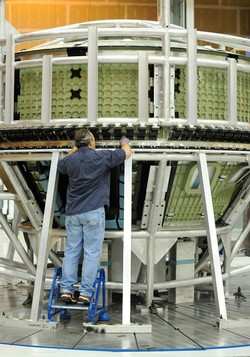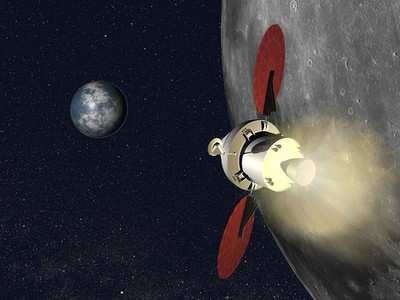Wed, Jun 16, 2010
Prime Contractor Lockheed Martin Fuses The Two Halves Of The
Crew Module
The Orion crew exploration vehicle took shape as the two halves
of the crew module were fused together at NASA's Michoud Assembly
Facility in New Orleans, LA Tuesday. The Lockheed Martin Orion team
welded the forward cone assembly to the aft barrel assembly using
the next generation friction stir weld process. The 445-inch long
weld is the longest such weld of its kind and will ensure optimal
structural integrity for the harsh environments of space
flight.

Orion Crew Module Takes Shape
The completion of the crew module welds marked another key
milestone for the Orion crew exploration vehicle, completing the
structural framework of the spacecraft. All welds have met
stringent quality requirements without any rework required. Prior
to flight testing, this crew module will be tested on the ground in
flight-like environments, including static vibration, acoustic, and
water landing tests. Results will be used to correlate sizing
models for all subsystems on the vehicle.
Orion weld operations take place on a Universal Weld System II
(UWS II) that includes a 22-foot diameter turntable, a
self-reacting friction stir weld head and a modular t-grid floor.
The system affords virtually unlimited five-axis welding on
fixture-mounted hardware. The UWS II is part of the National Center
for Advanced Manufacturing, managed by the University of New
Orleans Foundation in partnership with NASA and the State of
Louisiana.

Artist's Rendering Orion Returning From The
Moon
The friction stir welding process advances the state-of-the-art
for circumferential welds, yielding higher strength and higher
quality welds at a lower cost. The latest state-of-the-art
manufacturing technologies, efficient processes and new materials,
such as the ultra-light weight Aluminum-Lithium alloy, are all
being employed on Orion to produce the lightest possible vehicle
for space flight.
"The combination of material and manufacturing advancements in
technology are key reasons why the spacecraft is more lightweight
and damage resistant than many industry experts thought possible,"
said Larry Price, Lockheed Martin Orion deputy program manager.
"The balance of manufacturing methods and varied materials such as
composites and advanced alloys that have been applied to Orion
resulted in vehicle optimizations across the board - lowest cost,
lightest weight, and improved structural integrity, which is
critical to crew safety."
More News
He Attempted To Restart The Engine Three Times. On The Third Restart Attempt, He Noticed That Flames Were Coming Out From The Right Wing Near The Fuel Cap Analysis: The pilot repor>[...]
Make Sure You NEVER Miss A New Story From Aero-News Network Do you ever feel like you never see posts from a certain person or page on Facebook or Instagram? Here’s how you c>[...]
From 2009 (YouTube Edition): Leading Air Show Performers Give Their Best Advice for Newcomers On December 6th through December 9th, the Paris Las Vegas Hotel hosted over 1,500 air >[...]
Aero Linx: NASA ASRS ASRS captures confidential reports, analyzes the resulting aviation safety data, and disseminates vital information to the aviation community. The ASRS is an i>[...]
“For our inaugural Pylon Racing Seminar in Roswell, we were thrilled to certify 60 pilots across our six closed-course pylon race classes. Not only did this year’s PRS >[...]
 NTSB Final Report: Rutan Long-EZ
NTSB Final Report: Rutan Long-EZ ANN FAQ: Turn On Post Notifications
ANN FAQ: Turn On Post Notifications Classic Aero-TV: ICAS Perspectives - Advice for New Air Show Performers
Classic Aero-TV: ICAS Perspectives - Advice for New Air Show Performers ANN's Daily Aero-Linx (06.28.25)
ANN's Daily Aero-Linx (06.28.25) Aero-News: Quote of the Day (06.28.25)
Aero-News: Quote of the Day (06.28.25)




